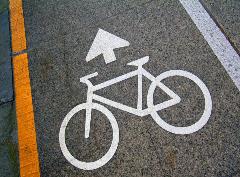Melissa Bopp, Ph.D., FACSM |
March
23, 2018
We’ve all heard the expression, “If you build it, they will come.” Does it apply to bike lanes and cyclists? If we paint some lanes on the side of the road will we be overrun with cyclists? Is it really that simple? Is there anything beyond the bike lane that we can do to promote more participation in transportation-related biking? The simple answer is, indeed, yes there is. 
The issue of understanding and promoting bicycling behavior is certainly complex, one pondered by a variety of stakeholders, including urban planners, traffic engineers, health officials and local biking advocates to name a few. It is important to note that it is, in fact, a BEHAVIOR that we’re trying to understand. Just like any other behavior (e.g., smoking, healthy eating, etc.), there is a wide range of things that impact the behavior, from the individual all the way to public policy. It’s important to identify these things because they give us something to target with programs or approaches.
Perhaps one of the greatest influences on biking behavior is the individual themselves—mostly their thoughts, attitudes and beliefs about bicycling. Their confidence for bicycling in urban spaces could also be a factor, all of which could relate to how much they actually enjoy biking. Social networks also can play a big role in whether a person opts to bike—if they have friends, family or coworkers who bike regularly, that can positively impact their own choices. Seeing others biking in the community also speaks to a better “biking culture” in which one feels more comfortable hitting the roads on two wheels when it seems there is more of a critical mass.
Some of the farthest-reaching approaches include the education, encouragement and supportive infrastructure (e.g., bike parking, locker rooms) that common destinations can provide. Schools and worksites are places that millions visit daily, so their role in promoting biking is essential and provides a connection to the greater community’s approach to biking. Policies at the local, state or federal level can offer support for biking through safety, education and the provision of resources. And, of course, the physical environment is another key component. It’s no surprise that features like shared use paths, protected bike lanes, traffic calming and connections with public transportation promote biking.
Community leaders, key stakeholders or policymakers need to fully understand the expansive benefits associated with biking in order to garner support and resources to support this mode of travel. Beyond the notable benefits of improved health outcomes, bicycling as a sustainable form of transportation has significant “green” outcomes as well. The primary environmental benefits associated with biking are related to the shift in travel mode away from automobiles, with potential benefits of reduced pollution, traffic, congestion and improved air quality, resulting in a more sustainable environment. Air pollution and poor air quality have been linked to many chronic diseases (e.g., respiratory conditions, cardiovascular disease, lung cancer), poorer quality of life, premature mortality, increased health care expenses and increased absenteeism at work and school. Estimates have shown that a mode share shift to more active modes of travel (i.e., biking) could save from four to 23 million tons of carbon a year for trips of less than three miles. Shifting travel patterns from automobiles to biking has clear implications for the environment, so understanding the influences on biking behavior is key on the pathway to more sustainable living.
Whether as a stakeholder, advocate, or bicyclist, it is important to pose the questions, “Should we build it? Will they come?” But we must remember what lies beyond the bike lane.
Melissa Bopp is an associate professor of Kinesiology at Pennsylvania State University and author of the forthcoming book: Biking for Transportation: An Evidence-base for Communities.